Forums:
I got some seed of Pedicularis oederii and haven't a clue what to do with it. Help, please!! Ironically, I did a bunch of research on germination, but found some interesting information about hosts for the plants, but nothing about how to actually germinate the seed.

Comments
Jan Jeddeloh
Re: Pedicularis
Wed, 11/23/2011 - 1:01pmI've always heard it's impossible to grow up if you succeed be sure and post whatever magic incantation you use.
Jan
Trond Hoy
Re: Pedicularis
Wed, 11/23/2011 - 1:22pmThe few times I have tried I've always sowed in situ. I think Pedicularis need a host - often grass but I am not sure. I do not now whether my efforts have been successful but I think so because I have noticed an increasing amount of still nonflowering small plants.
Here are a few pictures of P oederi (gullmyrklegg) a native here. No references to sowing though.
http://www.google.no/search?q=gullmyrklegg&hl=no&client=firefox-a&rls=or...
Lori S. (not verified)
Re: Pedicularis
Wed, 11/23/2011 - 8:37pmDr. Deno, in his publications, reported only on P. rainierensis, which he germinated at room temp using GA-3 (72% germination in 1-4 weeks). The only other comment is that the seeds were dead after 2 years of dry storage.
Mark McDonough
Re: Pedicularis
Wed, 11/23/2011 - 8:52pmNot that I have much to offer here, but I do recall encountering P. rainierensis while hiking up into the higher altitudes of Mt. Rainier, an evocative first-class plant to be sure, much like the dwarf P. oederi.
Tim Ingram (not verified)
Re: Pedicularis
Wed, 11/23/2011 - 9:47pmI have no experience of growing these remarkable plants but know that David and Stella Rankin (Kevock Plants) in Edinburgh have had some trials with them. They may have been selling them as small seedlings before they had made any association with host plants? Cliff has put some wonderful images of many of these hemi-parasitic plants on the IRG section of the SRGC site. Castilleja seem easier to grow and Paul Cumbleton at Wisley has written on these in The Plantsman Vol. 7, 2008, p.218-221 - will have to look out to see how well they might do on the new crevice garden.
John P. Weiser
Re: Pedicularis
Thu, 11/24/2011 - 10:04amYou can all try your hand at germinating seed from Pedicularis groenlandica. I sent seed into the exchange this year.
I would surface sow them and keep the pots very damp exposing them to vernalization. In my view, it would make sense to seed a moisture loving grass or sedge in the pot with them, so they can establish a bond as early as possible.
Here are several photos of Pedicularis groenlandica growing on a fen in the Sierra Nevada.
Trond Hoy
Re: Pedicularis
Thu, 11/24/2011 - 11:37amOne more at my list!
Lori S. (not verified)
Re: Pedicularis
Thu, 11/24/2011 - 10:18pmWell, I had to look up Pedicularis rainierensis - a lovely thing, to be sure!
http://www.pnwflowers.com/flower/pedicularis-rainierensis
http://www.wnps.org/plants/pedicularis_rainierensis.html
http://calphotos.berkeley.edu/cgi/img_query?enlarge=0000+0000+0807+1142
I dunno about the following photo, though; it looks to me like Pedicularis contorta or something a lot like it. What do you think?
http://nwwildflowers.wordpress.com/2011/10/29/mt-rainier-lousewort-pedic...
(There's a really cute lupin in the foreground of that pic.)
P. oederii is lovely too - the brown tips to the flowers make it especially interesting. How tall does it get?

Here's another absolutely stunning one... Pedicularis arctica. I've only seen these in one place (an alpine ridge in Banff) so far, and only a little colony of 2 or 3 plants. The height was only about 6-8 cm.
Mark McDonough
Re: Pedicularis
Fri, 11/25/2011 - 5:31amLori, you have a sharp eye, I believe you are correct that the image in the nwwildflowers link is incorrectly identified as P. rainierensis, does indeed look like it is P. contorta. I checked out one of my favorite floras of the area, the Burke Museum of Natural History, they always have excellent plant photos, and on their Pedicularis summary page 6 species are listed, including both rainierensis and contorta. It's worth making a comment on the nwwildflowers site, so I did.
http://biology.burke.washington.edu/herbarium/imagecollection.php?Genus=...
...and some good photos of P. rainierensis one this page, scroll to bottom:
http://biology.burke.washington.edu/herbarium/imagecollection.php?ID=4310
The little blue lupine in the nwwildflowers link is Lupinus lepidus, most likely var. lobbii which is very common in the Mt. Rainier area. On Burrough's Mt. area ( a"spur" off of Mt. Rainier, on the "dry side" of the mountain), it grew by the acre mixed in with golden Erigeron aureus, the blue and gold combination a most memorable site.
http://biology.burke.washington.edu/herbarium/imagecollection.php?ID=1932
Lori S. (not verified)
Re: Pedicularis
Fri, 11/25/2011 - 6:49amAh, I wondered if it might be the same species we were talking about in the other thread! What a vivid flower colour in the photo.
Peter George
Re: Pedicularis
Fri, 11/25/2011 - 8:50amIn my research on the genus Pedicularis, I discovered that one of the commonest 'associations' is a member of the genus Salix. Lori's photo above shows a Pedicularis and I believe it's growing with one or more Salix plants. So what I'm going to do is set out some of my seed in an area of the garden where I'm growing an unnamed Salix from Newfoundland. It will be interesting to see what happens.
Trond Hoy
Re: Pedicularis
Sat, 11/26/2011 - 8:58amI found out that at least some Pedicularis species are hemiparasitic on Dryas roots. Also species in the Ericaceae family (particularly Vaccinium), Carex, Betula and Salix are important. It seems Vaccinium species are mentioned as the most important hosts. (Macinnes 1972, Canada)
http://www.arc-da.no/terrok/08/8.html
Robert Nold
Re: Pedicularis
Tue, 11/29/2011 - 8:49pmHmm. I could almost read the Norwegian. (I can read German.)
I've seen "little red elephants" or "elephant heads" (Pedicularis groenlandica) growing at the edges of seeps along the high mountain passes here, with orchids, etc., but never noticed an association with other plants.
If they're like castilleja, the hemiparasitic nature means that the seed can be sown in pots without a host plant, but may need to be planted out next to a host.
I've also heard that it really doesn't matter what the host plant is (with castilleja).
Bob
Lori S. (not verified)
Re: Pedicularis
Tue, 11/29/2011 - 9:26pmIn these parts, I don't tend to see Pedicularis groenlandica in the alpine zone much, and I think of it as being largely more montane to subalpine-ish... I do see it in the subalpine, where springs emerge, where there is a dense growth and high number of of other species, and along lake shores where again there is heavy plant growth, and also along river and streams where there may be relatively few other species in the gravelly bank.
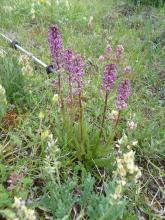
Here it is, for example, in a rich subalpine area where springs provide moisture:
P. bracteosa also seems to be more subalpine-montane here also, again in wet areas generally with lots of other plant growth:
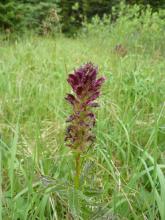
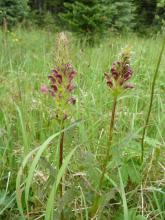
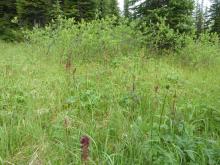
I've only seen P. contorta around here in the alpine zone and in snowier areas, where there is nonetheless, a fairly good plant growth with a few different species... certainly in areas where Dryas, Salix and alpine Carex grow:
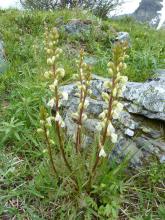
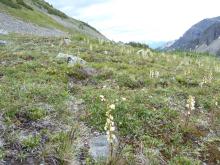
It seems to me that Vaccinium ssp. tend to be in the forest understory here, rather than out in the flowery subalpine or alpine meadows where Pedicularis hang out... although I guess I could see an association happening between, say, P. bracteosa and Vaccinium in montane forest clearings?
So,what to make of it all????
Trond Hoy
Re: Pedicularis
Wed, 11/30/2011 - 12:38pmIf you can read German then Norwegian isn't that difficult ;) You just mix English and German ;D
Whenever I lay my hands on Pedicularis seed I prefere to sow in situ. Seems that many species can use different taxa as hosts. I disperse the seed on different subsrates hoping that at least one site is to its preference.
Robert Nold
Re: Pedicularis
Thu, 12/01/2011 - 11:43amI'm beginning to think that sowing in situ is the best way to go for almost everything, if you have no greenhouse. Certainly, I would say, for astragalus and other fabaceous species. (i know this is heresy.)
And in the case of hemiparasites I would say that they surely have a better chance of getting established being sown in situ. Less opportunity for maladjustment to the hemiparasitic life, you might say.
Bob